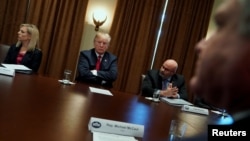President Donald Trump is portraying the violent MS-13 gang as a collection of immigrants sneaking illegally into the U.S., an account that ignores the organization’s homegrown roots and the fact many of its members are U.S. citizens.
That may suit his attempt to link illegal immigration to criminal behavior, but it’s not an accurate depiction of a gang that blends foreigners and Americans and is therefore partly out of reach of border guards and other immigration authorities. Nor is he telling it straight when he says Democrats have demonstrated indifference to the problem: President Barack Obama took unprecedented actions against the gang.
In addition to his recent rhetoric on MS-13, Trump complained Wednesday that investors caused a slump in the stock market despite good economic news, unlike the “old days” when good news meant rising stocks. That’s a mischaracterization of how the market works.
A look at those statements:
TRUMP: “MS-13 recruits through our broken immigration system, violating our borders, and it just comes right through; whenever they want to come through, they come through. It’s much tougher now since we’ve been there. But we need much better border mechanisms and much better border security. We need the wall.” — Remarks Tuesday at a meeting with law enforcement officials.
THE FACTS: A wall might conceivably slow but can’t stop MS-13, because it is well established in the U.S. and has many U.S. citizens in its ranks — people who can’t be denied entry based on their nationality, or deported.
The gang started in the 1980s in Los Angeles, initially made up largely of refugees and other immigrants from El Salvador, and “spread quickly across the country,” according to a Justice Department fact sheet. An FBI assessment from January 2008 said the gang was operating in at least 42 states and the District of Columbia, roughly the same number of states estimated in 2017. It has also spread outside the U.S.
That FBI assessment said the group was made up largely of first-generation Americans and Salvadoran nationals. A decade later, the government has not said how many it thinks are citizens and immigrants. In notable raids on MS-13 in 2015 and 2016, most of the people caught were found to be U.S. citizens.
Despite the gang’s decades-old history in the U.S., Trump has routinely overstated the immigrant component, saying in May 2017 it’s a “large group of gangs that have been let into our country over a fairly short period of time” and blaming the Obama administration for having “allowed bad MS-13 gangs to form in cities across U.S.”
TRUMP: “The ones that don’t want security at the southern border, or any other border, are the Democrats. They don’t care about the security of our country. They don’t care about MS-13 killers pouring into our country. ... Nobody was bringing them out before us.” — Speech Monday on Ohio.
THE FACTS: Recent history does not show such indifference. The U.S. carried out record deportations during the Obama administration and, on MS-13 specifically, took the unprecedented action of labeling the street gang a transnational criminal organization and announcing a freeze on its U.S. assets.
Trump’s own Justice Department has indirectly credited the Obama administration, in its early years, with putting heavy pressure on the gang. It said, “Through the combined efforts of federal, state and local law enforcement, great progress was made diminishing or severely (disrupting) the gang within certain targeted areas of the U.S. by 2009 and 2010.” That was not enough to crush MS-13 and Trump is taking extra steps toward that goal. But he is not the first to go after the gang.
The results so far are not clear. Attorney General Jeff Sessions said last month the U.S. has “worked with our international allies to arrest or charge more than 4,000 MS-13 members.” That suggests at least some of the 4,000 weren’t in the U.S. when they were arrested and aren’t now in U.S. prisons.
TRUMP: “In the `old days,’ when good news was reported, the Stock Market would go up. Today, when good news is reported, the Stock Market goes down. Big mistake, and we have so much good [great] news about the economy!” — Tweet Wednesday.
THE FACTS: It’s not that simple, and it’s not true that a positive economic indicator necessarily means a rise in stocks. The opposite can happen, depending on what sort of chain reaction is anticipated by investors.
The market dive was prompted in part by the news that wages are rising at the best pace in eight years after a prolonged bout of sluggish gains. Higher wages can lead to more inflation. The Fed could try to restrain inflation by raising interest rates, which would hurt corporate profits and limit the pace of economic growth. That’s how good news for workers can come with a downside for investors.
Likewise, bad news can make the market rise. In 2016, for example, the Labor Department initially reported that employers added a mere 38,000 jobs in May. After slipping that day, the Dow Jones industrial average climbed the next trading day. A weak jobs report can cause stocks to dip briefly, then surge the following days on the belief that the Fed will hold off on rate increases.
Associated Press writers Jill Colvin and Eric Tucker contributed to this report.
AP Fact Check: Trump Overlooks MS-13 Gang’s American Roots
update






